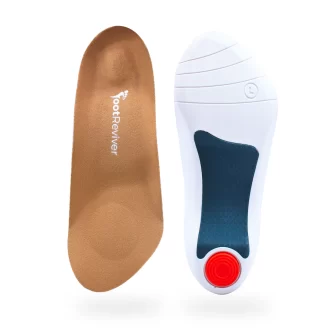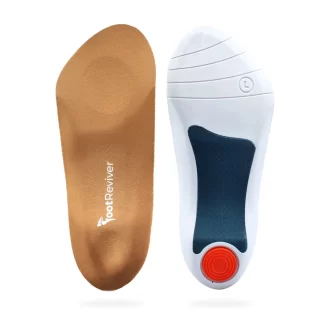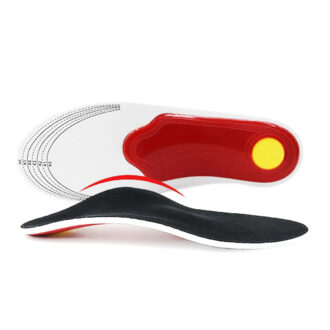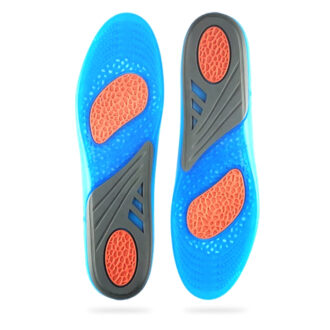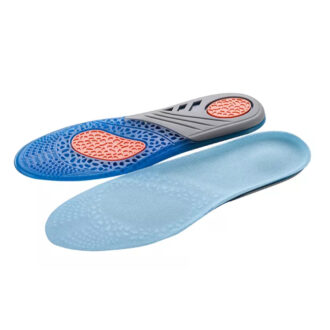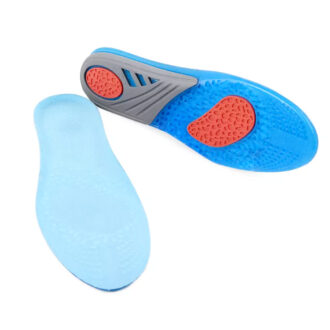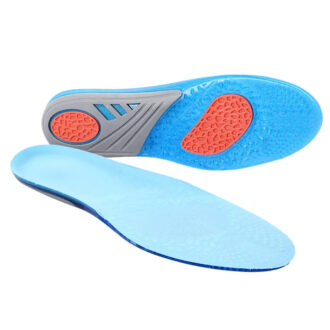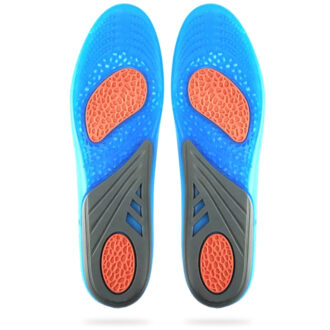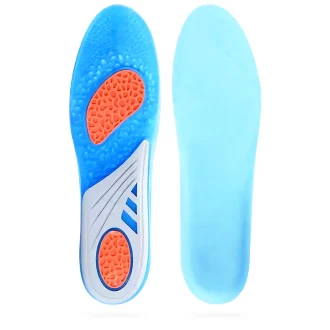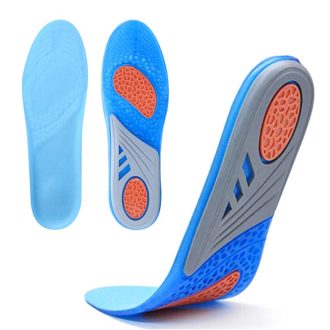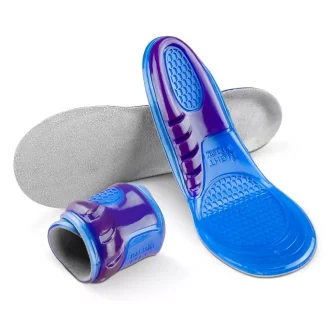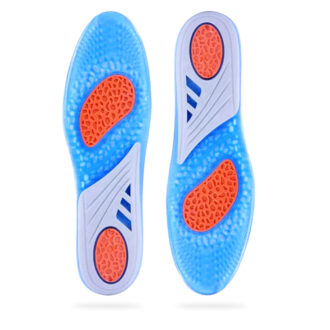No products in the cart.
Shoe insoles
Tired, sore feet can turn simple tasks into hard work. Long spells on hard floors and those first steps after sitting can trigger sharp or aching pain. Shoe insoles add targeted support under the heel, arch, and forefoot so pressure spreads more evenly and each movement feels steadier. With the right fit, every step can become calmer and more controlled while you get on with your day. If you’re managing plantar heel pain, arch strain, forefoot hot spots, or aches higher up linked to foot mechanics, this page will help you choose and use insoles with confidence.
The gait cycle, made simple
Every step follows a familiar rhythm: you meet the ground, roll forward, then push away. At the start of the step, the heel should meet the ground level so you feel stable. As weight moves forward, the arch lowers a little to help absorb shock and guide the body ahead. As you leave the ground, the toes bend and the ball of the foot provides a smooth, even push‑off. In a comfortable stride, these changes feel easy and predictable.
Small differences in landing and roll‑through change where pressure builds. If the heel tips inward and the arch drops quickly, the inner edge works harder and tissues there brace step after step—often felt as inner‑arch or inner‑ankle strain. If the heel tips outward and the arch stays high and stiff, force focuses at the heel and along the outer forefoot—often felt as sharp heel contacts or outer‑edge soreness. If you push off from a small patch, hot spots form. These shifts don’t stay local; they influence how the lower leg turns and how stable each step feels. With that foundation, the next question is where that load tends to go on your feet.
Foot shape and shoe fit: how pressure is shared
We’ve looked at how a step rolls from heel to toe. Where that load ends up on your foot comes down to two important things: your foot shape and how your shoes fit.
Two important things shape your pressure pattern—your arch shape and the room inside your shoes, especially across the midfoot and forefoot.
- Lower arches: the inside of the foot meets the ground earlier and can drop quickly as you load it. Inner‑side tissues then work harder each step and weight shifts to the inside—often felt as inner‑arch or inside‑ankle fatigue by afternoon.
- Higher arches: with less midfoot contact, more force goes straight to the heel and the ball of the foot. On side‑slanted sections the outer edge can feel overworked, and on hard surfaces the front of the foot may feel hot or sore sooner.
- Midfoot room and heel hold: if the midfoot is squeezed, load moves to the front of the foot faster; if heel hold is loose, landings can tip in or out and feel less stable. Both change how quickly pressure shifts as you roll forward.
- Forefoot space and shape: tight or tapered fronts narrow the contact area under the ball of the foot, concentrating pressure into a smaller patch. Thinner or stiffer forefoot cushioning can intensify this on hard ground.
Across a busy day, these patterns push more work onto one area and shape how each step feels. They also set the starting position for the rest of the leg—how the ankle, shin, knee, and hip line up—so small improvements here can make movement feel steadier higher up. That link is the kinetic chain.
The kinetic chain, in practice
Your foot, ankle, knee, hip, and lower back work as one linked system—often called the kinetic chain. The way the heel lands and the arch moves affects how the shin turns, how the kneecap tracks, and how the thigh moves in the hip. When landings are level, arch motion is controlled, and push‑off is balanced, the joints above tend to follow a calmer path. That’s why a change you feel under the foot often shows up as steadier steps higher up. With this in mind, here’s how insoles guide the step without getting in the way of your natural motion.
How insoles help, step by step
Insoles help by guiding three key moments in each step while keeping your foot’s natural motion.
- Start of the step: a deep, shaped heel cup holds the heel upright so the step begins level and feels steadier. Optional heel cushioning and, in some designs, a small central heel recess soften sharp contacts without adding wobble.
- Through the middle: a contoured midfoot platform increases contact along the arch so more of the sole shares load and the arch lowers in a measured way. Subtle sidewalls blending from the heel into the midfoot limit excess inward or outward roll while still allowing natural flex.
- Leaving the ground: an evenly cushioned forefoot with gentle flex grooves encourages a central push‑off and stops pressure collecting under a small patch. Where helpful, a low metatarsal lift sits just behind the ball of the foot to help spread load.
Together these changes reduce repeated strain while keeping movement natural. These step‑by‑step effects align with independent clinical guidance and pressure‑mapping patterns in everyday use. If you’re wondering whether insoles are advised beyond the foot itself, the answer is yes.
Why insoles are recommended
Independent guidance for common foot, knee, hip, and lower‑back problems includes supportive prefabricated inserts as part of early care. Randomised comparisons of supportive inserts versus flat inserts report useful improvements in pain and function over several weeks of daily use, and pressure‑mapping studies consistently show reduced peaks under the heel and forefoot with a steadier path of weight through the arch. Results vary person to person, but the pattern is reliable—especially when inserts are used alongside sensible load management, supportive footwear, and a gradual build‑up of activity. For specifics, explore the conditions below.
Explore common conditions
Built To Our Clinical Standard
Now that you know why insoles help, here’s what every model in our range delivers. Each insole meets the same high bar: secure heel control, anatomically contoured support where present, and durable cushioning that resists flattening under repeated use. If a design does not meet that standard, it is not included—simple as that. Every model is developed with podiatry and biomechanics experience and verified in real day‑to‑day use such as commuting, school runs, longer periods on your feet, and active days. We specify medical‑grade foams, gels, and supportive frames that hold their shape, with smooth, low‑friction top layers and clean edge finishing to reduce rubbing when worn with socks. The differences between models are type (full‑length, 3/4‑length, heel cups or pads, lifts, height‑adding), profile (slim or more structured), and feel (plush or springy)—not the level of support or build quality. Here’s how to choose among them.
Types In Our Range And When They Fit Best
Choosing the right type starts with the space inside your shoes and how you spend your day. Full‑length insoles cover heel to toe and suit shoes with removable liners, providing guidance and cushioning across the whole step. Three‑quarter‑length insoles sit under the heel and midfoot and leave the toe area clear, which works well in lower‑volume shoes that have less room in front. Heel cups and heel pads focus on the rearfoot when you want cushioning and control without changing space around the toes. Heel lifts add a small rise at the heel for situations where easing the back of the ankle helps; use within recommended heights for your shoes. Height‑adding insoles give discreet extra height while maintaining secure heel control and cushioning. Running and active insoles are tuned for repeated impacts and longer distances, pairing stable heel control with responsive forefoot cushioning.
Features And What They Do
Across our range, you’ll find a wide choice of insoles with different features combined to suit foot types, shoe space, and daily routines. Not every model includes every feature—and that’s intentional. Each design focuses on the effects that matter most, while every pair meets the same standard for secure heel control, guided support, and long‑lasting cushioning.
From heel to toe, here’s how the features work together.
Steadier heel at landing. A deep heel cup (heel cradle) with a supportive rim and contoured sidewalls holds the heel upright and centred at first contact, promoting a level, controlled step. Some designs add a small central heel recess to ease peak pressure while preserving control; others add targeted rearfoot cushioning to take the edge off firm ground without introducing wobble. Support that steadies the arch. A contoured midfoot platform increases contact along the arch so more of the sole shares load and the arch lowers in a measured way as you roll forward. Subtle side support blending from the heel into the midfoot helps limit excess inward or outward roll while still allowing natural flex. Left/right‑specific shaping follows small differences between your feet for a closer, more consistent feel. Cushioning for a calm step.Softer zones where you land and steadier support where you push off make impact feel gentler while keeping movement composed and controlled. The aim is day‑long comfort without bounce or wobble. Even pressure at push‑off. A low metatarsal lift set just behind the ball of the foot helps distribute pressure so one small area doesn’t carry the whole push‑off. An evenly cushioned forefoot smooths the last part of the step, and subtle forefoot flex grooves help the insole bend with your toes so push‑off feels natural—even in shoes with stiffer soles.
Details that keep comfort consistent.
Smooth edges for easy wear. Low‑friction top layers, tapered, bevelled edges, and a low‑profile front reduce rubbing with socks and let the insole sit flush inside the shoe, keeping guidance steady from morning to evening.
Practical features for everyday use.
Breathable top cover. Perforations and moisture‑managing layers help move air and manage sweat; some designs include odour‑control finishes. Easy trim‑to‑fit length.Clear toe guides make it simple to fine‑tune length for a precise fit across different shoes. Stays put inside the shoe. A lightly textured underside helps the insole stay in place inside smooth‑lined shoes, keeping guidance consistent step after step. Profiles and arch shapes for different feet and shoes.Offered in slim, standard, and extra‑cushioned profiles to suit different shoe volumes, with arch contours in neutral, moderate, and high shapes to suit low, neutral, or high arches. Built for your kind of day. Constructions vary by routine—steady all‑day standing, repeated impacts, or low‑profile support for tighter shoes—tailoring guidance and cushioning to different demands.
Materials And How They Feel
Materials shape both comfort and durability, so we match them to the job. EVA provides light, springy support that holds shape well for day‑to‑day wear. PU foams add durable, elastic cushioning that resists flattening over time. Silicone‑based gels are used in focused zones under the heel or forefoot to dampen impact where it is highest. Memory foam, when used as a top layer, offers a plush feel and pressure relief; it works best over a supportive base that keeps guidance consistent. Thin, open‑cell damping foams are placed under the heel and just behind the forefoot to absorb repeated contacts without adding bulk. Rigid or semi‑rigid frames in the rearfoot and midfoot keep shape for consistent heel control. These materials are combined to deliver the feel you prefer—plush, springy, or more stable—within the space available in your shoes.
How To Choose
Use the pointers below to pick a pair that suits your feet and your shoes. If the sharpest moments are at the heel, look for a deeper heel cradle with reliable rearfoot cushioning. If the inner arch or inside of the ankle tires and aches, pair a secure heel cradle with support under the arch that increases midfoot contact. If burning or pinpoint soreness sits under the forefoot later in the day, choose a metatarsal lift with an even, cushioned forefoot. If you carry pressure along the outer edge and feel less stable on sloped ground, look for extra midfoot contact with subtle guidance and good cushioning. If you run or train, introduce insoles during easy sessions first, then extend to longer or faster work as comfort allows. If you’re between two options, pick the type that fits your shoe space, then fine‑tune comfort with small position adjustments during first use.
Sizing And Compatibility
Comfort depends on how the insole sits inside your shoes. Choose the type that suits the space available. Roomier pairs with removable liners accommodate full‑length designs comfortably. Closer‑fitting pairs often suit three‑quarter‑length insoles or slim full‑length profiles. If your shoes already feel tight, start with three‑quarter‑length insoles or heel pads to preserve toe space. If you prefer to leave the front of the shoe unchanged, heel cups or heel pads can add comfort without affecting toe space.
Fit And Wear
A good fit lets the design work as intended. Place the insole flat on the shoe base; if your shoes have removable liners, replace them so the insole sits directly on the base. Seat your heel fully in the cradle and check the support under the arch meets your foot comfortably. Confirm you have clear space around your toes. Small position adjustments—only a few millimetres—can improve comfort; check both feet as they rarely feel identical.
What To Expect In The First 2–4 Weeks
Early changes are normal while your feet adapt to a more even load. Many people notice a gentler feel under the heel and a steadier step. It’s common to feel new areas of light contact under the arch or around the heel cradle as load spreads more evenly. Mild arch or calf fatigue can appear in the first days and usually settles as you adjust to the new support and cushioning.
The Break‑In Period
As more of the sole shares load and the heel lands more centrally, tissues in the foot and lower leg change their timing and effort. Start with the parts of your day that usually bring on discomfort, then extend wear time. Many people adapt in a few days; sensitive feet or higher activity levels may take two to four weeks. Mild, settling soreness is typical during this phase. Sharp, focal pain or symptoms that worsen day by day are not—reduce wear time, adjust position slightly, or seek personalised guidance.
Care, How Long They Last, And Replacement
While the insoles in our range are built to last, a little care helps them last longer and keeps their support and cushioning consistent. We use durable, medical‑grade materials and support structures designed for repeated use without losing shape quickly. Air them after use, wipe with a damp cloth when needed, and avoid high heat. How long your insoles last depends on the distance you cover, your bodyweight, the hardness of the surfaces you use most, and how closely they fit the shoes you wear. Replace when cushioning no longer feels present or when supportive contours under the heel and arch feel flattened.
Important Information
Build up wear time gradually and start with the parts of your day that usually bring on discomfort. Check for rubbing or pressure points and stop use if pain increases or if numbness, tingling, or colour changes persist. Do not use over open wounds or suspected infection. Insoles support day‑to‑day comfort but do not replace personalised care; if pain is severe, began after a fall or twist, or is not improving, seek professional advice. If you have a known sensitivity to specific materials, check product details and discontinue use if irritation occurs.
FAQs
Which insoles are best for standing all day?
Look for medium‑to‑firm support with a deep heel cup, balanced arch contact, and rearfoot cushioning for softer landings and stable guidance.
Can I use insoles in multiple shoes?
Yes, but frequent swapping can reduce longevity. Consider a pair per frequently used shoe for best results.
Do I remove the original shoe insole?
If the shoe feels tight, remove the original footbed. If there’s space, layering the new insole over the original can add extra cushioning.
How do I choose the right arch support?
Match to your arch height and shoe volume: low arches often prefer a structured contour; high arches often like added midfoot contact plus cushioning; neutral arches tend to do well with moderate support that doesn’t feel intrusive.
Your next steps
Level landings, more even support, and a centred push‑off can make everyday walking feel easier. Every model in this range meets our clinical standard for stability, guidance, and durable cushioning. Choose insoles with a secure heel cup (to level landings), supportive arch contours (to share load and steady motion), and a smooth, cushioned forefoot platform (to keep push‑off from the centre and soften contacts). Wear them for everyday walks and longer periods on firm ground, then extend use as comfort builds. If they’re not right for you, use our 30‑day comfort guarantee to return them and try another option.
Plantar Fasciitis Arch Support 3/4 Length Heel Pain Relief Insoles
- 1x Pair of Arch Support Insoles — FootReviver Arch Support Insoles designed to steady your heel, support your arch, and help ease plantar‑fasciitis‑related heel discomfort during everyday wear
- For Men & Women
- Available in UK sizes 7–11 and 3–7; trim‑to‑fit forefoot for a closer match
- Slim 3/4‑length design fits most everyday shoes quickly and easily while leaving toes free
- Semi‑rigid plastic arch support, deep heel cup, and gentle medial posting (a small inner‑edge lift that guides alignment) help reduce excess inward roll and the strain it can place on the inner heel, arch, and plantar fascia
- Dual‑density foam cushioning with a built‑in heel pad absorbs impact while keeping midfoot support stable
- Soft, breathable fabric top cover with a moisture‑wicking surface helps keep feet drier and reduces rubbing; smooth against the skin to reduce irritation
- A practical choice for long shifts on your feet—retail, hospitality, healthcare—and for feet with low or high arches that benefit from steady support
- Designed to reduce strain on the plantar fascia and support comfortable daily movement; results vary and this is not a medical device
- Lightweight, durable, and easy to swap between shoes; trim the forefoot only, then seat the heel cup flush at the back
- Includes a full 30‑day money‑back guarantee
£9.99£10.99inc VATOrthotic Heel Pad Plantar Fasciitis Inserts
- Are you struggling with heel pain that gets worse when walking or standing for extended periods, especially on hard surfaces? We understand your discomfort and have a solution that could change your life. The FootReviver Orthotic Shoe Inserts for Plantar Fasciitis are designed with your comfort in mind.
- These shoe inserts are more than just regular insoles. They are expertly designed by FootReviver, a trusted name in the field of foot care. Each pair is created with the goal of providing the ultimate solution to heel pain, a common symptom of plantar fasciitis. When you choose our product, you are choosing quality and effectiveness.
- These inserts are a universal solution, perfect for both men and women. They come in two size ranges: 7-11 and 3-7, even having the flexibility to be custom cut to perfectly fit your shoe.
- The design is compact and 3/4 length, so these inserts can be fitted in virtually any type of shoe. Perfect for those who need to shift between different shoes throughout the day, such as office wear to running shoes, ensuring constant comfort and support.
- Primarily aimed at preventing plantar fasciitis in individuals with flat feet or high arches, the FootReviver Orthotic Shoe Inserts are designed to provide optimal arch support. This feature plays a crucial role in reducing the strain on the plantar fascia, preventing further damage and fostering healing. They are designed to ensure that your feet have the right support they need, whenever they need it.
- Crafted with top-quality, medical-grade materials, the inserts offer unparalleled cushioning. The solid carbon fiber shell heel cup absorbs shock, protects your lower limbs, and prevents pressure point build-up. This feature is particularly beneficial for those with active lifestyles or demanding work environments.
- These inserts are not just limited to plantar fasciitis. They offer relief for a range of foot and lower limb conditions including Heel Spurs, Arthritis, Metatarsalgia, Morton’s Neuroma, Bunions, Blisters, Sesamoiditis, Achilles tendonitis, Ankle sprains, and Shin Splints. They also help correct gait issues such as supination and overpronation, making them an all-in-one solution for foot health.
- The FootReviver Orthotic Inserts promise relief, comfort and improved foot health. They are lightweight yet durable, and can be trimmed to fit any footwear, making them a versatile addition to your footwear.
- We are confident in the performance of our inserts as we provide a full 30-day money-back guarantee. If you are not 100% satisfied with your purchase, we offer a no questions asked return policy, which reflects our belief in the effectiveness of our product.
- Please note: We strongly recommend consulting with your doctor before using our heel cups especially if your symptoms persist. Your health is our utmost priority, and we strive to provide the best possible solution for your heel pain. If you have any queries or require further assistance, our team at Nuovahealth is always ready to help.
£9.99£10.99inc VATInsoles for High Arches
- 1x Pair of Orthotic Insoles for people with high arches or flat feet who suffer from foot and heel pain and are wanting fast effective relief
- For both Men & Women
- Can be slipped quickly and easily into a range of different shoes including casual everyday shoes and running trainers
- Rigid arch support ergonomically designed to support your feet in the correct position helping to reduce strain and pressure on your feet as you walk
- Perfect for treating and preventing a wide range of foot injuries including Metatarsalgia, Plantar fasciitis, Heel Spurs and Achilles tendinitis
- Ideal for people with high arches or who suffer from biomechanical imbalances such as overpronation and supination
- Features a deep heel cup that helps keep your heels supported and protected
- Made from lightweight shock absorbing carbon fibre material
- Includes a full 30 day money back guarantee if you are not 100% satisfied with your purchase!
£9.99£11.99inc VATGel Arch Support Compression Sleeves for Plantar Fasciitis relief & Flat Feet
- 1x Pair of Gel Arch Support Foot Compression Sleeves for Plantar Fasciitis & Flat Feet
- For both Men & Women
- One size fits most
- Recommended for people who have flat feet or high arches and are more predisposed to foot pain and injuries
- Treats and prevents Plantar fasciitis, Metatarsalgia, Morton’s Neuroma, Arthritis, Sesamoiditis, Bunions, Calluses, Blisters, Foot fatigue, Sprains and Strains, Poor circulation, Neuropathy, Achilles tendonitis, Shin Splints and more!
- Features Inbuilt gel arch support that has been designed specially to mould to the exact shape and contours of your feet and provides a custom level of support to help ease strain and pressure off your arches (plantar fascia ligament) allowing your feet to recover faster from overuse injuries such as Plantar fasciitis
- Medical grade silicone gel absorbs shock and vibrations and spreads pressure evenly underneath your foot preventing pressure points from forming and protecting your damaged plantar fascia from further damage
- Provides mild compression to your feet that can help improve blood flow to them, reduce inflammation and swelling and ease aches and pains deep within your feet
- They slip-on easily around your feet and can be worn with or without socks or shoes
- Can be worn for day-day wearing or for running, sports and exercises to better support, compress and protect your feet
- Prevents imbalances such as Overpronation and Supination during gait that can cause abnormal load on your feet and cause overuse injuries including plantar fasciitis which is one of the leading causes of foot and heel pain in adults
- An ideal solution for people who are required to stand for long periods of time on hard surfaces such as concrete and wooden flooring and suffer from tired aching feet and legs
- Includes a full 30-day money back guarantee!
£7.99inc VATMorton’s Neuroma Insoles with Forefoot cushioning & Metatarsal support
- 1x Pair of Morton’s Neuroma Insoles with Forefoot cushioning & Metatarsal support designed to help relieve Morton’s neuroma by reducing pressure in the webspace and sharing load across the forefoot, so walking feels more comfortable and flare‑ups are less likely during daily activity.
- Unisex fit for Men and Women, available in US sizes 3–9 and 7–13; trim the forefoot to your shoe using the printed size guide for an accurate, secure fit.
- Helpful as part of conservative care for forefoot overload and foot‑posture issues—including Morton’s neuroma, metatarsalgia, sesamoiditis, bunion‑related pain, flat feet, high arches, overpronation, supination, and plantar fasciitis—while promoting a more even step to ease knock‑on ankle, knee, hip, and low‑back fatigue.
- Forefoot offloading: a metatarsal support positioned just behind the ball of the foot encourages slight forefoot splay and reduces pressure on the interdigital nerve; targeted cushioning softens contact under the metatarsal heads.
- Gait support: the contoured arch helps limit excessive inward roll, while the cupped heel improves landing consistency—together promoting a more even step so the forefoot is not repeatedly overloaded.
- Heel and ankle stability: the shaped heel cup helps centre the heel at contact and reduces wobble through mid‑stance, supporting a smoother transition toward toe‑off with less strain on sensitive areas.
- Comfortable construction: soft, durable silicone‑gel base with a low‑friction top surface that conforms to your foot, helps reduce rubbing, and maintains comfortable contact across longer periods on your feet.
- All‑day standing support: designed to spread load and reduce local pressure points on firm floors, making them suitable for work shifts or daily routines that involve extended standing and walking.
- Use with care during flares: in more irritable phases, you can pair these insoles with slim metatarsal offloading pads placed just behind the tender spot when advised for extra pressure relief.
- 30‑day money‑back guarantee: try them in your regular footwear and daily routine; if they are not right for you, return them within 30 days for a refund.
£10.99inc VATSoothing Gel Shoe Insoles for Diabetes
- 1x Pair of Soothing gel shoe insoles for people suffering from Diabetes & Neuropathy
- For both Men & Women
- Available in 3-9 & 7-13 USA shoe sizes (can be trimmed easily to the right fit using scissors and the size guide printed onto the back of insoles)
- Massages your feet and stimulates the blood vessels and nerves in them as you walk to boost the circulation to them to help
- Reduce numbness, fatigue, stiffness, swelling and inflammation and speeds up the natural healing process of damaged tissue
- The silicone gel that these insoles are made from will help to restore balance to your feet by moulding to the exact shape and contours of them and give you a custom level of support
- Supports your arches and heels in the correct position and prevent common gait problems such as overpronation and supination from damaging your feet
- Shock absorption helps deplete impacts felt when walking, running and jumping protecting your feet and lower limbs from pain and injury
- The silicone gel helps spread weight and pressure evenly underneath your soles stopping pressure points from forming and causing damage to your feet making these insoles ideal for people who spend long amounts of time on their feet on hard surfaces and suffer from tired aching feet and legs
- Features specially designed anti-slip technology which will keep your feet in securely place and stops them from rubbing against the sides of your shoes and causing blisters and bunions to develop
- Recommended by Podiatrists for helping treat a number of foot and lower limb injuries and conditions such as Plantar fasciitis, Flat feet, High arches, Collapsed arches, Arthritis, Metatarsalgia, Hammer toes, Pes Cavus, Atrophy, Sesamoiditis, Cuboid Syndrome, Foot drop, Heel spurs, Heel bursitis, Achilles tendonitis, Shin splints and much more!
- Designed to be as lightweight, breathable, durable and as slim as possible to fit inside just about any type of shoes easily
- Includes a full 30-day money back guarantee!
£10.99inc VATGel Shoe Insoles for Atrophy of the fat pad, Cuboid Syndrome, Foot fatigue, Drop Foot & Heel bursitis
- 1x Pair of Gel Shoe Insoles for Atrophy of the fat pad, Cuboid Syndrome, Foot fatigue, Drop Foot, Heel bursitis and more!
- For both Men & Women
- Available in USA shoe sizes 3-9 & 7-13 (trim to fit)
- Helps keep your feet supported and comfortable when wearing shoes for long periods of time
- Features advanced inbuilt arch support that helps prevent common gait problems such as overpronation and supination and stops abnormal load and pressure from damaging and inflaming your plantar fascia ligaments and causing plantar fasciitis
- Specially designed heel cup and support technology helps to better support and stabilize your heels and ankle protecting them from shock, pressure and strain
- These gel insoles are often highly recommended by Podiatrists to help ease foot and heel pain and treat common foot injuries and problems including Flat feet, Plantar fasciitis, Heel Spurs, Metatarsalgia, Atrophy of the fat pad, Cuboid Syndrome, Foot fatigue, Drop Foot, Heel bursitis, Sesamoiditis, Morton’s Neuroma, Arthritis, Neuropathy, Ankle sprains and more!
- Designed to soothe and massage your feet as you walk and helps stimulates your blood vessels to improve circulation in them and speed up and improve injury recovery
- Lightweight, slim and breathable and breathable made from premium durable materials
- Great for running, exercising, playing sports or general everyday wear
- Includes a full 30-day money back guarantee!
£10.99inc VATOrthotic Gel Shoe Insoles for Heel Spurs
- 1x Pair of Orthotic Gel Shoe Insoles designed to ease heel pain and for preventing and stopping Heel Spurs from getting worse
- For both Men & Women
- Available in 3-9 & 7-13 USA shoe sizes
- Specially designed to reduce pressure and stop abnormal load on your heel bones to prevent heel spurs from developing or worsening
- Great for people who have flat feet, high arches or suffer from gait problems such as Overpronation and Supination which puts more pressure on your feet when you walk
- Made from medical grade shock absorbing silicone gel that cushions and protects your feet and heel from shock, vibrations and impacts and helps spread weight and pressure evenly underneath your feet stopping pressure points from developing and causing damage and pain to them
- Can also be worn to help treat, ease and prevent Arthritis, Gout, Foot fatigue, Diabetic foot, Neuropathy, Raynaud’s disease, Plantar fasciitis, Heel Bursitis, Foot drop, Metatarsalgia, Morton’s Neuroma, Achilles tendonitis, Cuboid Syndrome, Ankle and Foot fractures, Shin splints as well as pain in your knees and lower back
- Advanced arch support technology properly supports the arches of your feet taking strain and pressure off key ligaments found in your feet such as your plantar fascia ligament to help prevent overuse injuries including Plantar fasciitis
- Inbuilt stabilizing heel cups built into the insoles helps to support and realign your heels and ankles in the correct position and prevent movement which can cause injury to them
- Ideal for people who suffer from tired aching feet or legs when standing for long periods of time
- Features anti-slip technology that stops your feet from moving around and rubbing against the sides of your shoes and causing blisters to develop
- Includes a full 30-day money back guarantee!
£10.99inc VATMassaging gel insoles for Blisters
- 1x Pair of FootReviver™ Orthotic Gel insoles for treating and easing blisters effectively by stopping your feet from rubbing against your shoes
- For both Men & Women
- Available in 3-9 & 7-13 USA shoe sizes (trim to right size using scissors)
- Features a soft velvet top layer and a shock absorbing silicone gel bottom layer that will help to protect your feet and keep them comfortable all day long
- Can be placed in the fridge to cool down for a few minutes to provide soothing cold therapy to your feet to help ease pain caused by blisters
- Helps alleviate pressure and stops rubbing and chaffing on your feet to treat and prevent blisters
- Soothing massaging gel eases aches and pains and stimulate blood flow to your flow to help promote the natural healing process of damaged tissue
- Ideal for people who find themselves stood for long amounts of time and suffer from tired aching feet and legs
- Realigns and supports your feet in the correct position and corrects your gait to help stop your feet from moving excessively in your shoes and rubbing against the sides which often can cause blisters to develop
- These insoles can also be worn to also help treat and ease a range of other foot and lower limb injuries and conditions and not just blisters including Bunions, Plantar Fasciitis, Metatarsalgia, Morton’s Neuroma, Arthritis and Achilles tendonitis
- Can be fitted inside a range of footwear and are great for running, sports and everyday use
- Please note: To avoid blisters you must make sure that your shoes are not too tight or too loose and that the insoles fit properly inside of them
- These insoles make an excellent combo with a pair of blister protection sleeves available here.
- Includes a full 30-day money back guarantee!
£10.99inc VATEveryday Comfort Gel Walking Insoles
- 1x Pair of Everyday Comfort Gel Walking Insoles specially created for people who love to walk or run long distances and don’t want painful aching feet or legs
- For both Men & Women
- Available in 3-9 & 9-13 USA shoe sizes (trim to fit using scissors)
- The soothing silicone gel that these insoles are made from will help to massage and relax your feet as you walk not only that, but this specially designed gel will also help to stop pressure points from developing underneath your feet by evenly spreading weight across your soles
- Designed to cushion and protect your feet from shock and impacts created when your feet strike the ground when you are walking, running or jumping
- Features inbuilt arch support technology that has been specially designed to support the arches of your feet in the optimum position and helps take strain and pressure off your arches to prevent overuse injuries such as Plantar fasciitis
- These walking insoles are lightweight, breathable and durable and can be slipped easily inside many different types of footwear including Walking shoes and Boots, Trainers, Work boots, High heels, Slippers, as well as Casual and Formal shoes
- Helps stop heel pain in its tracks by stabilizing and supporting your heels and ankles and prevents twisting and excessive movement of your feet which can cause injuries such as ankle sprain and Achilles tendonitis from occurring
- Highly recommended for people with Flat feet, High arches, Supination, Overpronation, Plantar Fasciitis, Heel Spurs, Bunions, Metatarsalgia, Sesamoiditis, Morton’s Neuroma, Diabetes, Cuboid Syndrome, Achilles tendonitis, Shin splints, Patella tendonitis, as well as Knee, hip and back pain
- Designed to help fix your gait when you walk preventing excessive pronation during the gait cycle in order to minimize the pressure being put on your feet and prevent injuries from developing
- Includes a full 30-day money back guarantee!
£10.99inc VATSoothing gel insoles for Neuropathy
- 1x Pair of soothing massaging gel Orthotic insoles ideal for people suffering from Neuropathy, Diabetes and Poor circulation
- For both Men & Women
- Available in 3-9 & 7-13 USA shoe sizes
- Helps massage your feet whilst you are walking to stimulate the blood vessels and nerves in your feet with the aim of helping to improve circulation, soothe aches and pains and reduce stiffness and numbness
- Recommended for people suffering from a range of different foot conditions and injuries including Neuropathy, Diabetes, Poor circulation, Raynaud’s disease, Oedema (swollen feet), Arthritis, Falt feet, High arches, Supination, Overpronation, Plantar Fasciitis, Heel Spurs, Metatarsalgia, Morton’s Neuroma, Achilles tendonitis, Shin splints, knee and lower pain plus more!
- Corrects your gait to prevent excessive pronation when you walk which is a leading cause of overuse injuries in your feet and lower limbs
- Made from high quality medical grade silicone gel that absorbs shock and prevents pressure points from forming and damaging your feet when you are stood for long periods of time on hard surfaces such as wooden flooring and concrete
- Can be slipped easily inside many different types of footwear and can be carefully trimmed to the right fit using the sharp pair of scissors with the size guide printed on the insoles themselves
- Innovative solid shell heel cups support and realign your heels and ankles and prevent excessive movement which can cause injury to them
- Built in arch support helps to prevent abnormal load from damaging your plantar fascia ligament and causing plantar fasciitis
- Great for people who are always on their feet, love to walk, run or playing sports
- Includes a full 30-day money back guarantee!
£10.99inc VATShock absorbing insoles for Trainers & Running shoes
- 1x Pair of Shock absorbing gel shoe insoles for Trainers & Running shoes crafted from medical grade silicone gel to help protect your feet and lower limbs from pain and injury
- For both Men & Women
- Available in 3-9 & 7-13 USA shoe sizes
- Designed for athletes and runners wanting to protect not only their feet but also their lower limbs from pain and injury
- Ideal for people with Diabetes, Flat feet, high arches or those with gait problems such as Overpronation and supination which often makes them predisposed to foot and lower limb injuries and pain as a result
- Recommended for treating and preventing Arthritis, Plantar Fasciitis, Metatarsalgia, Neuropathy, Poor circulation, Raynaud’s disease, Pes Cavus, Morton’s Neuroma, Metatarsal fractures, Atrophy of the fat pad, Heel Bursitis, Cuboid Syndrome, Drop Foot, Achilles tendonitis, Ankle sprains and strains, Shin Splints and knee, hip and lower back pain and injuries
- Advanced arch support system helps alleviate pressure and reduces abnormal load off your arches protecting your plantar fascia from overuse injuries such as Plantar fasciitis
- Features innovative heel support that stops heel pain and injuries in their tracks by stabilizing and supporting your heels in the correct position and preventing pressure points by spreading weight evenly underneath your heels
- Provides Forefoot cushioning that helps ease and prevent metatarsalgia and Morton’s Neuroma
- The honeycomb design helps keep air circulating around your feet keeping them dry and fresh and also absorbs shock and impacts when your foot strikes the ground
- Features anti-slip Technolgy that keeps your feet firmly in place stopping them from moving around and rubbing against the sides of your shoes which often causes blisters to develop
- Soothes, massages and stimulates your feet as you walk helping increase blood flow to them boost blood flow and reduce excess fluid, inflammation and swelling and speed up healing of damaged tissue
- Supports and adjusts your gait with the aim of fixing common biomechanical imbalances such as overpronation and supination that can lead to injury
- Includes a full 30-day money back guarantee!
£10.99inc VATShock Absorbing Insoles for Achilles tendonitis
- Suffering from Achilles Tendonitis? Let us introduce you to a pair of expertly designed shock-absorbing insoles, crafted to provide unparalleled support and cushioning specifically for Achilles tendonitis sufferers. These insoles are engineered to distribute pressure evenly across your feet, reducing the strain on your Achilles tendon and promoting faster healing. Whether you’re an athlete or someone dealing with daily discomfort, these insoles are a game-changer in your path to recovery.
- Superior Cushioning and Support: Made from premium quality silicone gel, these insoles offer exceptional cushioning that absorbs shocks and vibrations, minimizing the impact on your Achilles tendon. This innovative design not only alleviates pain but also prevents further damage, allowing you to make a full and proper recovery without fear of reinjury.
- Maintain Proper Foot Alignment: One of the standout features of these insoles is their ability to maintain proper foot alignment. By correcting gait issues such as supination and overpronation, these insoles help prevent overuse injuries like Achilles tendonitis and Plantar Fasciitis. This ensures that your feet and lower limbs remain healthy and free from strain.
- Optimal Weight Distribution: These insoles are designed to spread and redistribute weight and pressure evenly across your feet. By protecting pressure points under your heels and soles, they provide much-needed relief and comfort. The 3/4 length solid shell heel support cup offers additional stability and prevents excessive movement that could further strain your Achilles tendon.
- Recommended for Multiple Conditions: While these insoles are perfect for easing Achilles tendonitis, they are also highly recommended by podiatrists for a range of other conditions. From Heel Spurs and Arthritis to Metatarsalgia and Morton’s Neuroma, these insoles provide comprehensive support and relief. They are even beneficial for more complex issues like Raynaud’s disease, Neuropathy, and Poor circulation.
- Improves Blood Circulation: Experience the added benefit of a gentle foot massage with each step. These insoles stimulate blood vessels in your feet, boosting circulation and reducing inflammation and swelling. This enhanced blood flow speeds up the natural healing process of damaged tendons, ligaments, muscles, and bones, making these insoles an invaluable addition to your recovery routine.
- Perfect for Active Lifestyles: Ergonomically designed to be lightweight, breathable, and durable, these insoles are ideal for runners, athletes, and anyone with an active lifestyle. Whether you’re running, climbing, cycling, or jumping, these insoles provide the extra support and protection you need to stay injury-free and perform at your best.
- Unmatched Guarantee: We stand by the quality and effectiveness of these insoles with a full 30-day money-back guarantee. If you’re not completely satisfied, simply return them for a full refund—no questions asked. This guarantee ensures that you can purchase with complete confidence, knowing that your investment in foot health is risk-free.
- Take the Step Towards Pain-Free Living: Don’t let Achilles tendonitis hold you back any longer. Invest in these shock-absorbing insoles today and experience the relief and comfort you deserve. Your feet will thank you!
£10.99inc VATGel Footbed Insoles for trainers
- 1x Pair of Gel Footbed Insoles for trainers and running shoes to help protect your feet and lower limbs from shock when running, exercising or playing sports
- For both Men & Women
- Available in sizes 6-9 & 8-12 (trim to fit)
- Recommended for people suffering from Plantar fasciitis, Heel Spurs, Flat feet, High arches, Achilles tendonitis, Arthritis, Neuropathy, Diabetes, Raynaud’s disease, Poor circulation, Metatarsalgia, Morton’s neuroma, Bunions, Pes Cavus, Sesamoiditis, Cuboid Syndrome, Ankle sprains, Shin splints as well as Knee, Hip and lower back pain
- Made from medical grade silicone gel that massages your feet and helps prevent foot fatigue and improves muscle recovery by stimulating the blood vessels in your feet to boost the circulation in them
- Helps cushion your feet and absorbs shock and vibrations whenever your feet strike the ground when walking, running and jumping to deplete the impact felt on key ligaments, tendons and joints found in your feet, knees, hips and lower back
- The silicone gel moulds to the exact shape and contours of your feet to provide a custom level of support and protection
- Helps correct common gait problems and biomechanical imbalances known to cause injury such as Overpronation and supination
- Provides supports your arches in the correct position and helps take strain and pressure off your plantar fascia ligament to help prevent and treat Plantar fasciitis
- 3/4 length heel cup provides extra support and stability to your heels and ankles and prevents heel pain by spreading weight evenly underneath your heels to stop pressure points from developing when stood for long period of time
- Lightweight and breathable design featuring moisture wicking technology and antibacterial properties to keep your feet fresh and odour free
- Includes a full 30-day money back guarantee!
£11.99inc VATFull-length Gel insoles for Bunions (Hallux Valgus)
- 1x Pair of Orthotic Gel Insoles that mould to the exact shape and contours of your feet help to protect and stop bunions from getting worse
- For both Men & Women
- Available in 3-9 & 7-13 USA shoe sizes
- Designed to stop bunions from getting worse by shielding them from shock and pressure and helps ease pain caused by them
- Improves the way your feet function to correct biomechanical imbalances such as supination and overpronation which are known to cause bunions to develop
- Recommended by Podiatrists for treating and easing Bunions, Arthritis, Metatarsalgia, Sesamoiditis, Morton’s Neuroma, Oedema, Neuropathy, Diabetes, Poor circulation, Raynaud’s disease, Fallen arches, Flat feet, Plantar Fasciitis, High arches, Cuboid Syndrome, Heel Spurs, Achilles tendonitis, Shin Splints as well as knee, hip and lower back pain
- Features specially adapted orthotic technology that helps corrects the way that you walk to place less strain and pressure on your feet to help you stay injury and pain free
- Inbuilt arch support system helps prevent abnormal load being put on your plantar fascia ligament protecting it from overuse injuries such as Plantar fasciitis
- Provides excellent shock absorption to protect your feet and lower limbs from shock, impacts and vibrations to prevent further pain and injuries developing
- Made from medical grade Silicone gel that is designed to soothe and massage your feet as you walk stimulating blood flow in your feet to help reduce swelling and inflammation, and supply damaged tissue with fresh oxygenated blood to speed up healing
- Supports your forefoot and metatarsal bones in the correct position helping to reduce the appearance overtime of bunions
- 3/4 length hard shell heel cup protects your heels from shock and injury and helps give your feet extra stability
- Ideal for wearing when standing for long periods of time – These insoles will spread weight and pressure underneath the soles of your feet stopping pressure points from forming and causing tired aching legs and feet
- Includes a full 30-day money back guarantee!
£10.99inc VATGel Metatarsal Support Insoles for Metatarsalgia (Ball of foot pain)
- 1x Pair of Orthotic Gel Metatarsal Support insoles specially designed to massage your feet and ease metatarsalgia (ball of foot pain)
- For both Men & Women
- Available in 3-9 & 7-13 USA shoe sizes (Trim accordingly using a sharp pair of scissors and the printed size guide printed on the insoles)
- Made from medical grade silicone gel that has been designed to massage and soothe your tired aching feet when you walk
- The silicone gel that these insoles are made from will also mould to the shape of your feet and provide a custom level of support and cushioning
- Recommended for treating and easing a range of different injuries and conditions that can cause metatarsalgia including Arthritis, Morton’s Neuroma, Bunions, Gout, Sesamoiditis, Calluses, Hammer toes, Metatarsal fractures, Atrophy of the fat pad, Claw toe and more!
- Helps protect, support and cushion the balls of your feet and helps realign your metatarsal bones into the correct position to stop you from damaging and injuring your feet
- Can be worn to help stimulate the nerves and blood vessels in your feet to help improve circulation, ease neuropathy and speed up the healing process of damaged muscles, ligaments and tendons in your feet
- Designed to prevent pressure points from developing when you are stood for long periods by redistributing weight and pressure evenly underneath the soles of your feet
- Inbuilt arch support helps keep strain and pressure off your arches and prevents overuse injuries such as Plantar fasciitis from occurring
- Features a 3/4 length heel cup helps give your heels and ankles more support and stability and prevents excessive movement from causing damage and injury to your feet and lower limbs
- Can be slipped inside virtually any type of footwear quickly and easily
- These insoles also work really well with a pair of our Metatarsal support foot pads available here!
£10.99inc VAT
